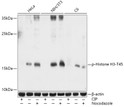| Tissue Specificity | P68431 - NAQ16695 - Expressed in testicular cells. |
| Alternative Antibody Names | Anti-Histone H3.1 antibodyAnti-Histone H3/A antibodyAnti-Histone H3/B antibodyAnti-Histone H3/C antibodyAnti-Histone H3/D antibodyAnti-Histone H3/F antibodyAnti-Histone H3/H antibodyAnti-Histone H3/I antibodyAnti-Histone H3/J antibodyAnti-Histone H3/K antibodyAnti-Histone H3/L antibodyAnti-H3C1 antibodyAnti-H3FA antibodyAnti-HIST1H3A.H3C2 antibodyAnti-H3FL antibodyAnti-HIST1H3B.H3C3 antibodyAnti-H3FC antibodyAnti-HIST1H3C.H3C4 antibodyAnti-H3FB antibodyAnti-HIST1H3D.H3C6 antibodyAnti-H3FD antibodyAnti-HIST1H3E.H3C7 antibodyAnti-H3FI antibodyAnti-HIST1H3F.H3C8 antibodyAnti-H3FH antibodyAnti-HIST1H3G.H3C10 antibodyAnti-H3FK antibodyAnti-HIST1H3H.H3C11 antibodyAnti-H3FF antibodyAnti-HIST1H3I.H3C12 antibodyAnti-H3FJ antibodyAnti-HIST1H3J antibodyAnti-Histone H3.1t antibodyAnti-H3/T antibodyAnti-H3t antibodyAnti-H3/G antibodyAnti-Histone H3.4 antibodyAnti-H3-4 antibodyAnti-H3FT antibodyAnti-HIST3H3 antibody |
Information sourced from Uniprot.org















